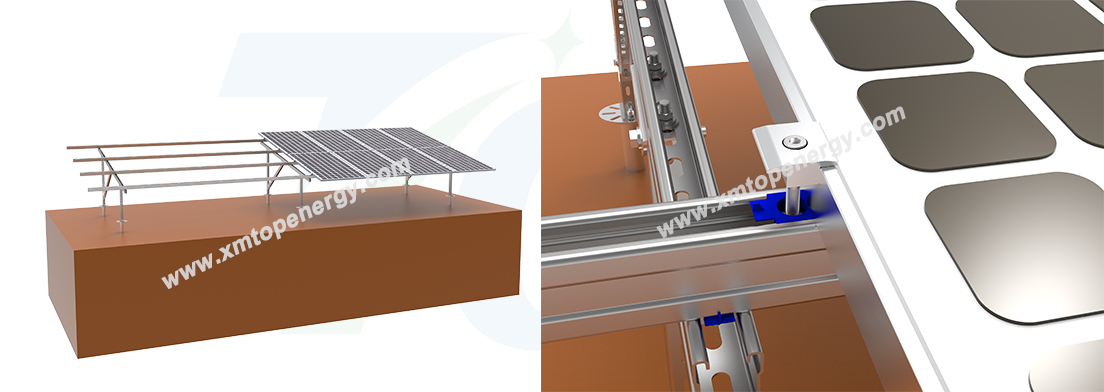Da die Solarenergiebranche weltweit weiter expandiert, bodenmontierte Solaranlagen sind zu einem wichtigen Bestandteil von Solaranlagen im Großanlagen- und Großgewerbe geworden. Um Sicherheit, Langlebigkeit und die Einhaltung nationaler Normen zu gewährleisten, müssen diese Anlagen verschiedene Zertifizierungen erfüllen, die von Land zu Land unterschiedlich sind. In diesem Artikel untersuchen wir die wichtigsten Zertifizierungsanforderungen für bodenmontierte Solaranlagen in mehreren wichtigen Solarmärkten.

UL 2703 : Sicherheitsstandard für PV-Montagesysteme, PV-Montagevorrichtungen, Klemmvorrichtungen und Erdungsösen.
IBC (Internationaler Baucode) : Einhaltung der örtlichen Bauvorschriften hinsichtlich Wind-, Schnee- und Erdbebenlasten.
ASCE 7 : Standard zur Bestimmung struktureller Belastungen durch Wind, Schnee, seismische Aktivitäten und mehr.
PE-Stempel : Für jeden Staat, in dem das Projekt umgesetzt wird, ist eine Bauingenieur-Zertifizierung (Stempel „Professional Engineer“) erforderlich.
Für Projekte auf Bundesland oder mit staatlichen Anreizen können zusätzliche Umwelt- und Strukturprüfungen erforderlich sein.
Eurocode (EN 1991-1-4 für Wind, EN 1991-1-3 für Schnee usw.) : Europäische Bemessungsnormen für den Hochbau.
CE-Kennzeichnung : Zeigt die Einhaltung der EU-Anforderungen in Bezug auf Sicherheit, Gesundheits- und Umweltschutz an.
ISO 9001 / ISO 14001 : Zertifizierungen für Qualitäts- und Umweltmanagementsysteme, die häufig von EPCs und Banken verlangt werden.
DIN-Normen (Deutschland) : Deutsche Bemessungs- und Prüfnormen, insbesondere DIN 1055 für Einwirkungen auf Tragwerke.
Erdungsschrauben und Fundamente erfordern oft eine geotechnische Genehmigung und Auszugsprüfberichte.

AS/NZS 1170-Serie : Strukturelle Entwurfsmaßnahmen einschließlich Wind-, Schnee- und Erdbebenlasten.
AS/NZS 4600 : Standard für kaltgeformte Stahlkonstruktionen.
AS/NZS 5033 : Installation von Photovoltaikanlagen (PV).
RPEQ-Zertifizierung (Registered Professional Engineer of Queensland): Erforderlich für Projekte in Queensland und einigen anderen Bundesstaaten.
Aufgrund der zyklongefährdeten Gebiete im Norden Australiens ist die Beurteilung der Windlast von entscheidender Bedeutung.
IS 875 Teil 3 : Verhaltenskodex für Windlasten.
IS 2062 : Standard für in Strukturen verwendete Stahlmaterialien.
MNRE-Richtlinien : Das Ministerium für Neue und Erneuerbare Energien bietet Leitlinien zu Qualitäts- und technischen Standards.
Tests durch Dritte : Oft werden NABL-akkreditierte Laborberichte zur strukturellen Integrität und Korrosionsbeständigkeit benötigt.
Bei öffentlichen Ausschreibungen kann eine BIS-Zertifizierung oder eine gleichwertige Überprüfung durch Dritte vorgeschrieben sein.

JIS-Standards (Japanische Industriestandards) : Wird auf Stahlmaterialien, Korrosionsprüfungen und strukturelle Festigkeit angewendet.
Baunormengesetz (BSL) : Muss den nationalen Vorschriften entsprechen, insbesondere in Erdbebengebieten.
JET-Zertifizierung : Die japanischen Labore für elektrische Sicherheit und Umwelttechnologie überprüfen häufig Komponenten von Solarprojekten.
Strukturanalyse : Erforderlich für Gebiete mit starkem Schneefall und Taifun-Gefahren.
Die Erdbebensicherheit hat hohe Priorität und erfordert eine detaillierte Bau- und Fundamentplanung.
GB 50009 : Lastcode für die Bemessung von Gebäudestrukturen.
GB/T 50797 : Entwurfsspezifikation für PV-Kraftwerksinstallationen.
Chinesische Klassifikationsgesellschaft (CCS) : Für einige exportorientierte Projekte kann eine Zertifizierung erforderlich sein.
Zertifizierung von Stahlkonstruktionen : QA/QC-Berichte und Werksqualifikationen werden häufig für große EPC-Projekte benötigt.
Für den Export in die EU oder die USA wird häufig die CE- oder UL-Konformität erwartet, auch wenn sie vor Ort nicht vorgeschrieben ist.

Häufig werden internationale Codes übernommen:
Eurocode oder ASCE 7 für die Tragwerksplanung.
Lokale Baugenehmigungen : Der technische Entwurf muss von zugelassenen örtlichen Ingenieuren genehmigt werden.
Werkstoffnormen für Stahl : Befolgen Sie normalerweise die ASTM- oder JIS-Standards.
Aufgrund der Bodenbeschaffenheit (z. B. Lehm, Neuland) sind häufig Pfahl- oder Erdschraubentests erforderlich.
Aufgrund des tropischen Klimas werden häufig Korrosionsschutzzertifikate (Feuerverzinkung gemäß ASTM A123 oder ISO 1461) angefordert.
Solar g runde Halterung Strukturen Je nach Installationsland unterliegen Solaranlagen einer Vielzahl von Zertifizierungen. Ob UL und ASCE in den USA, Eurocode in der EU oder IS-Codes in Indien – diese Normen gewährleisten die Sicherheit, Langlebigkeit und Einhaltung lokaler Vorschriften durch Solaranlagen. Für internationale Projektentwickler ist das Verständnis und die Einhaltung dieser Zertifizierungen für die Projektgenehmigung, Finanzierung und langfristige Leistung unerlässlich.

 Xiamen TopFence Co.,Ltd.
Xiamen TopFence Co.,Ltd. No. 77, LingXia South Road, Huli District, Xiamen City, Fujian, China
No. 77, LingXia South Road, Huli District, Xiamen City, Fujian, China Tel: +8613365923720
Tel: +8613365923720
 E-Mail: info@xmtopfence.com
E-Mail: info@xmtopfence.com
 IPv6 Netzwerk unterstützt Sitemap
| XML
| Blog
| Datenschutz-Bestimmungen
IPv6 Netzwerk unterstützt Sitemap
| XML
| Blog
| Datenschutz-Bestimmungen


